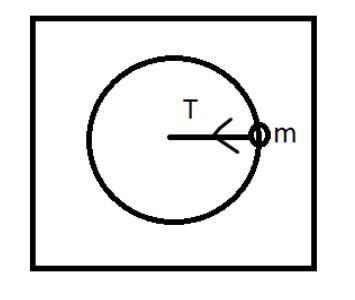
One end of string of length l is connected to a particle of mass ‘$m$’ and the other end is connected to a small peg on a smooth horizontal table. If the particle moves in circle with speed ‘$v$’, the net force on the particle (directed towards center) will be (T represents tension in the string)
(A) Zero
(B) \[T\]
(C) \[T + \dfrac{{m{v^2}}}{l}\]
(D) \[T - \dfrac{{m{v^2}}}{l}\]
Answer
216.6k+ views
Hint: Understand the concept of centripetal force and the normal force on a body. Apply the equations to the given scenario. It is given that the particle moves in a circular motion, and hence finds out the centripetal force to find tension.
Complete Step By Step Solution:
From the given statement, we can understand that an object m attached to string length L is placed on a smooth table. The diagram of the same is given below:

It is mentioned in the motion of objects to be circular. Hence the forces acting on the particle. One is the tension of the string. The normal reaction of the particle is given as \[N = m \times g\]
Now the Tension of the string is the centripetal force of the particle in circular motion, since tension acts at the central point of the motion.
This implies:
\[{F_c} = \dfrac{{m{v^2}}}{r}\]
\[{F_c} = \dfrac{{m{v^2}}}{l} = T\]
Therefore, the net force acting on the particle is the centripetal force Fc which is also equal to the tension acting on the string.
Hence, option (b) is the right answer for the given question.
Note:
Tension of a body is defined as the pulling force transmitted axially by either string or cable or chain. The tension always varies according to the length of the string. While considering a string or rope, the tension is felt across all ends of the string bidirectional except the end point where it is attached with. There will be tension on the end point from one side, when a mass is attached to one side.
Tension is the sum of pulling force \[m \times a\] and the force due to gravity \[m \times g\].
Complete Step By Step Solution:
From the given statement, we can understand that an object m attached to string length L is placed on a smooth table. The diagram of the same is given below:

It is mentioned in the motion of objects to be circular. Hence the forces acting on the particle. One is the tension of the string. The normal reaction of the particle is given as \[N = m \times g\]
Now the Tension of the string is the centripetal force of the particle in circular motion, since tension acts at the central point of the motion.
This implies:
\[{F_c} = \dfrac{{m{v^2}}}{r}\]
\[{F_c} = \dfrac{{m{v^2}}}{l} = T\]
Therefore, the net force acting on the particle is the centripetal force Fc which is also equal to the tension acting on the string.
Hence, option (b) is the right answer for the given question.
Note:
Tension of a body is defined as the pulling force transmitted axially by either string or cable or chain. The tension always varies according to the length of the string. While considering a string or rope, the tension is felt across all ends of the string bidirectional except the end point where it is attached with. There will be tension on the end point from one side, when a mass is attached to one side.
Tension is the sum of pulling force \[m \times a\] and the force due to gravity \[m \times g\].
Recently Updated Pages
JEE Atomic Structure and Chemical Bonding important Concepts and Tips

JEE Amino Acids and Peptides Important Concepts and Tips for Exam Preparation

Electricity and Magnetism Explained: Key Concepts & Applications

Chemical Properties of Hydrogen - Important Concepts for JEE Exam Preparation

JEE Energetics Important Concepts and Tips for Exam Preparation

JEE Isolation, Preparation and Properties of Non-metals Important Concepts and Tips for Exam Preparation

Trending doubts
JEE Main 2026: Application Form Open, Exam Dates, Syllabus, Eligibility & Question Papers

Derivation of Equation of Trajectory Explained for Students

Hybridisation in Chemistry – Concept, Types & Applications

Understanding the Angle of Deviation in a Prism

Understanding Collisions: Types and Examples for Students

How to Convert a Galvanometer into an Ammeter or Voltmeter

Other Pages
JEE Advanced Marks vs Ranks 2025: Understanding Category-wise Qualifying Marks and Previous Year Cut-offs

Units And Measurements Class 11 Physics Chapter 1 CBSE Notes - 2025-26

NCERT Solutions For Class 11 Physics Chapter 8 Mechanical Properties Of Solids

Motion in a Straight Line Class 11 Physics Chapter 2 CBSE Notes - 2025-26

NCERT Solutions for Class 11 Physics Chapter 7 Gravitation 2025-26

Understanding Atomic Structure for Beginners




